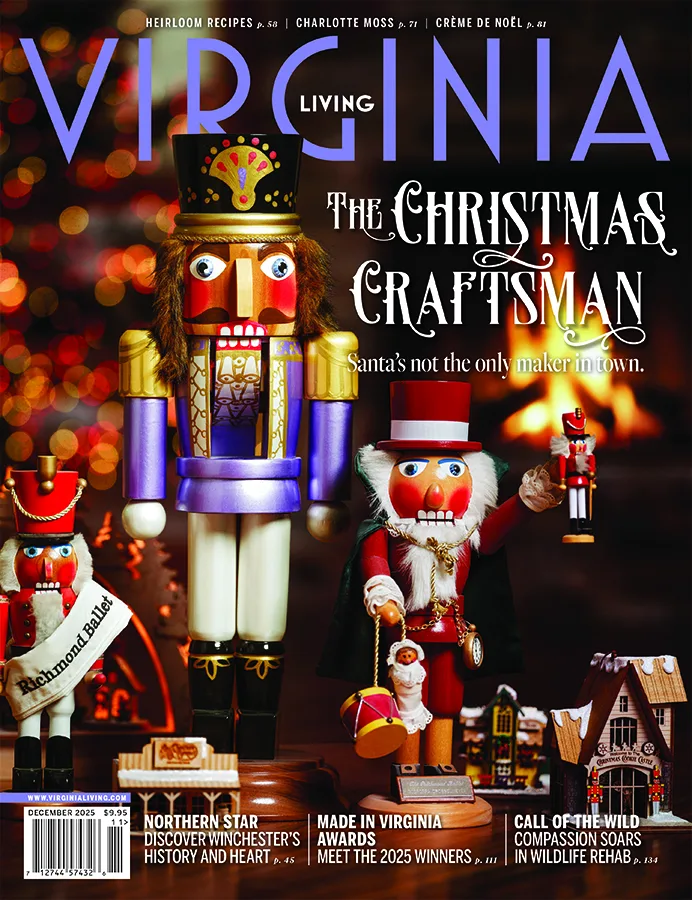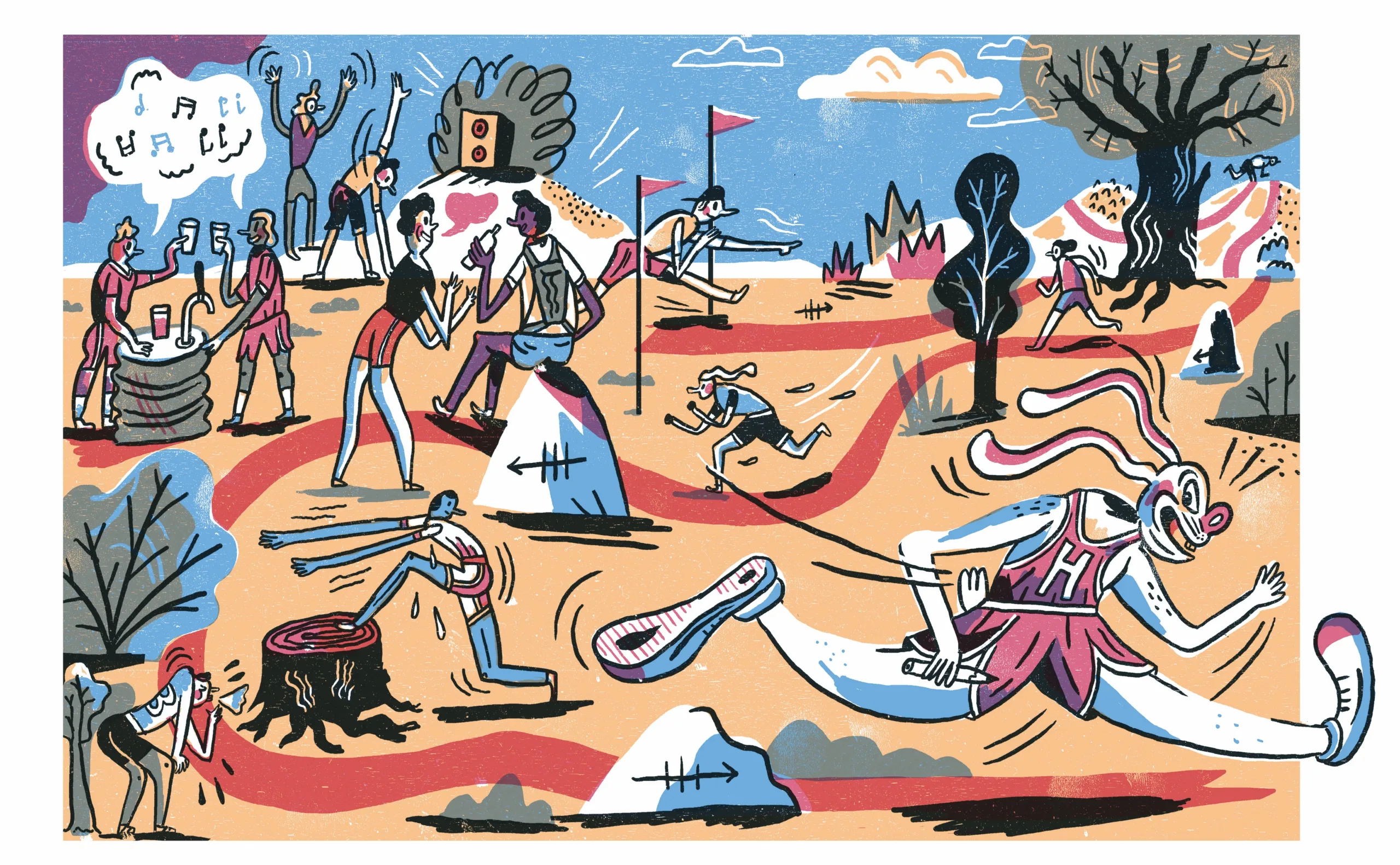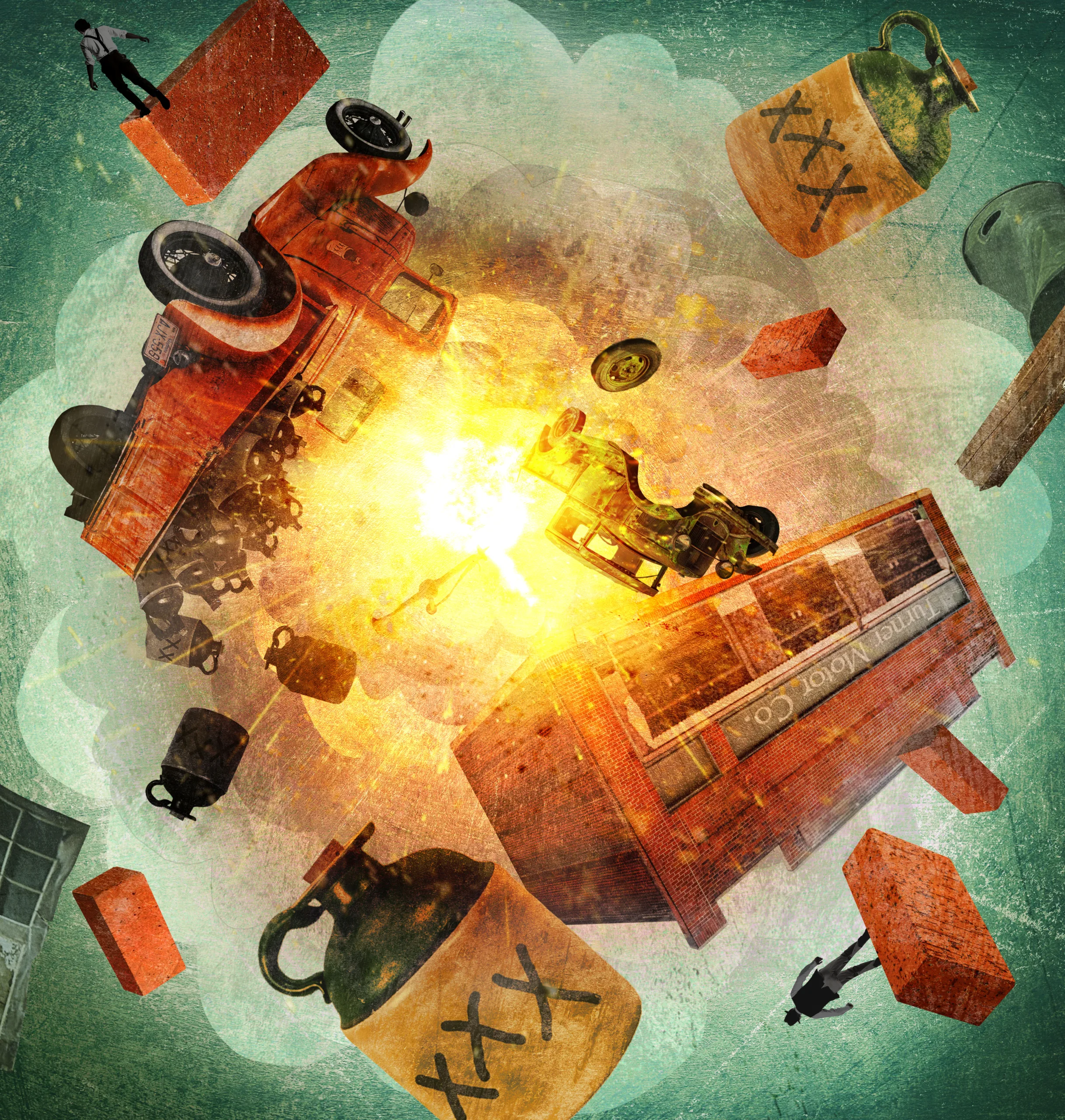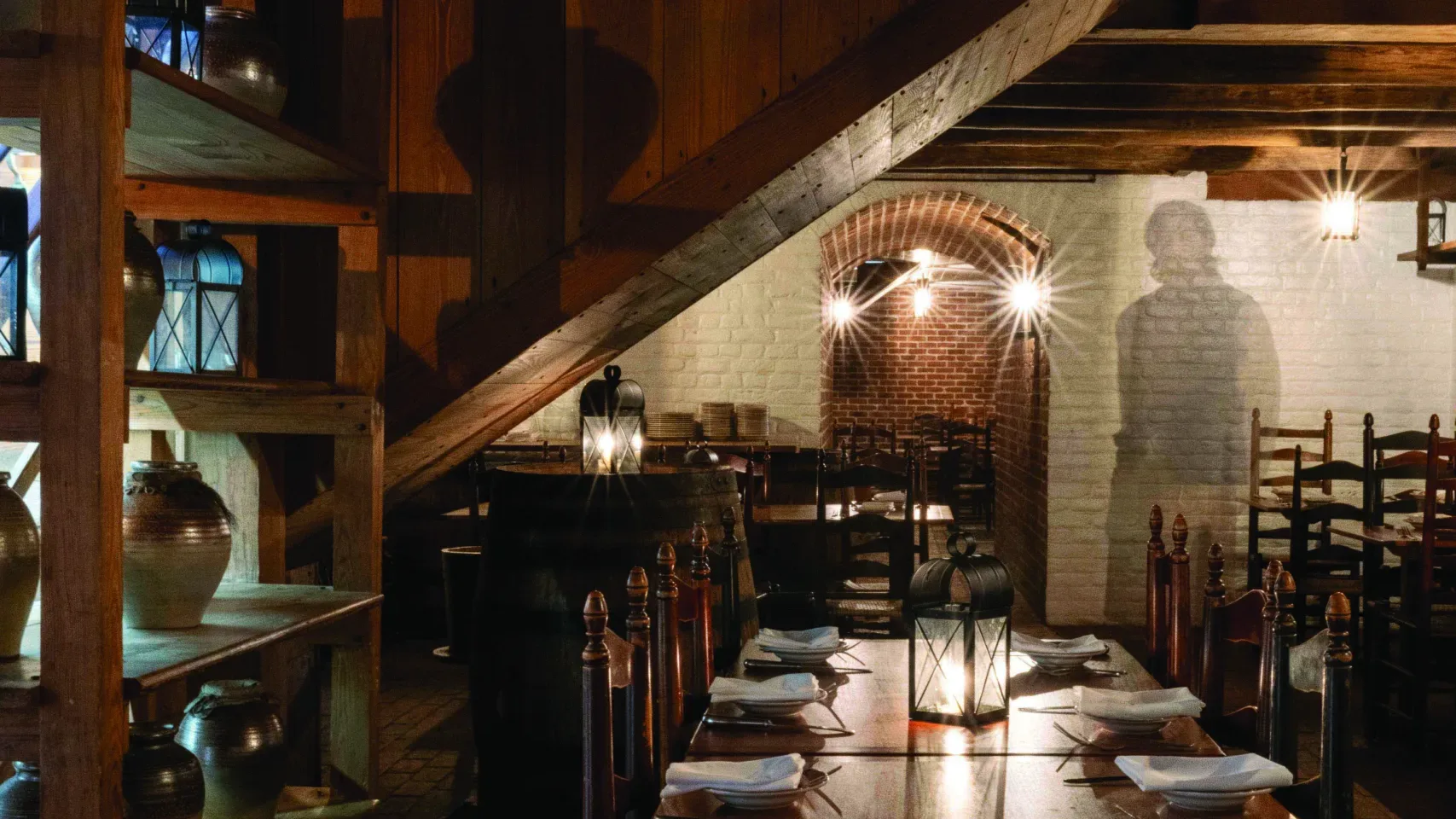My phone tells me the address is just up the street, to the left. It’s a parking garage, a big one, at least five stories.
The car in front of me turns in. That’s when I notice the custom license plate: “BRONCO.”
“Bronco Buster,” I mutter.
“Huh?” my eight-year-old son asks from the back seat.
“I bet that’s Bronco Buster,” I say. “She knows where she’s going.”
I follow her car as it winds the corners of the parking garage. It’s 10 a.m. on a Saturday, and there are a few cars parked on the first floor, but none on the second or third. We keep going.
We round our way to the top level, where a seemingly empty Northern Virginia parking garage transforms into what looks more like a tailgate party. There are 40 or 50 adults—plus half a dozen children and a few dogs—huddled around their cars singing bawdy drinking songs, doing a warm-up dance, and enjoying sodas, coffee, and other refreshments, some of the adult variety. Like Bronco Buster, each of these people has a code name.
Welcome to the wacky world of “hashing”—the biggest running club you’ve never heard of.
The Hash House Harriers, as the group is officially called, was founded in 1938 by British expats in Malaysia. It has since exploded into a worldwide phenomenon, boasting more than 1,000 clubs in more than 100 countries.
Despite their global reach, hashing clubs operate somewhat underground, spread mostly by word of mouth. Hashing is especially popular among members of the military and federal employees whose jobs require them to move every few years. No matter where they go, they can always find fellow hashers, with the clubs serving as a social outlet as much as a form of fitness. The group jokingly describes itself as “a drinking club with a running problem.”
The D.C. area is considered a hashing “megacenter,” home to over a dozen clubs, or “kennels,” as hashers say. In Virginia, there are at least 17 active kennels, according to an online directory, including clubs in NoVa, Richmond, Charlottesville, Blacksburg, and several in military-heavy Hampton Roads. The Richmond group says on its website, “We are a fun-loving, non-competitive running and social club that welcomes anyone who wants to join us for a good time.”
The runs are more like scavenger hunts, following a course laid by the “hare,” a volunteer who shows up a few hours early to plot the route. Often, there are separate courses for runners and walkers, usually two to five miles. The hare uses chalk or flour to draw symbols (“marks”) on the ground for the runners (“hounds”) to follow.
Bronco Buster and other hashers had explained all this to me a few weeks earlier, when I was a “virgin.” That’s what you’re called during your first hash. Club leaders are “mismanagers.” The $6 suggested donation is “hash cash.”
Hashing is an entire subculture, with plenty of off-color jokes that are part of the draw. It has its own vocabulary and a distinctive sense of humor, featuring lots of insults and self-deprecation–along with raunchy sayings and song lyrics that are not fit to print.
“It’s based on British humor, rugby humor,” says Bronco Buster, a retired foreign service
officer. “We poke fun at each other, but it’s out of love.”
She has hashed in more than 40 countries, plus Antarctica—yes, you read that right—but she says that with each hash she still feels “that sense of wonder.”
“It’s just beautiful,” she says. “You get to explore new places and see where you live differently.”
Today we’re exploring downtown Fairfax, near George Mason University.
It’s my second hash with the Mount Vernon Hash House Harriers, which has been active in the D.C. area since 1985. Most hashing clubs discourage bringing children and dogs due to the naughty songs and the sometimes rough terrain, but the Mount Vernon group is open to all ages, fitness levels, and breeds.
“On out!” someone yells.
The parking garage tailgate is over, and the chase is on.
My son and I hang back with the walkers as we follow the hare’s marks along sidewalks and through parking lots and neighborhoods. We meet a man whose hashing nickname is “Apparently Pregnant.” He’s a former U.S. diplomat who says he’s hashed in Poland, Malaysia, Burma, South Africa, Denmark, Russia, New Zealand, and more.
“Hashing brings together people from all walks of life, people who’ve experienced other cultures,” he says. “I’m able to let my hair down from a stressful job and become a complete childish loon.”
As we chat, we reach a chalk mark on the sidewalk. It’s a circle, meaning the next mark could be in any direction. But someone up ahead was looking out for us slow pokes, placing a twig on the circle pointing in the right direction.
And so we continue on, hounds in search of the hare.
The course ends at Mackenzie’s, a bar in Fairfax, where the drinking songs and rituals continue. There’s a roast, where club members are called out for alleged “sins” and “violations,” along with a hot sauce challenge and a surprise performance by a men’s a cappella group.
Amid all the commotion, the owner of the bar, Josh Alexander, tells me he loves hosting hashing clubs.
“They’re good people,” he says. “There’s nothing better than people who run and drink.”
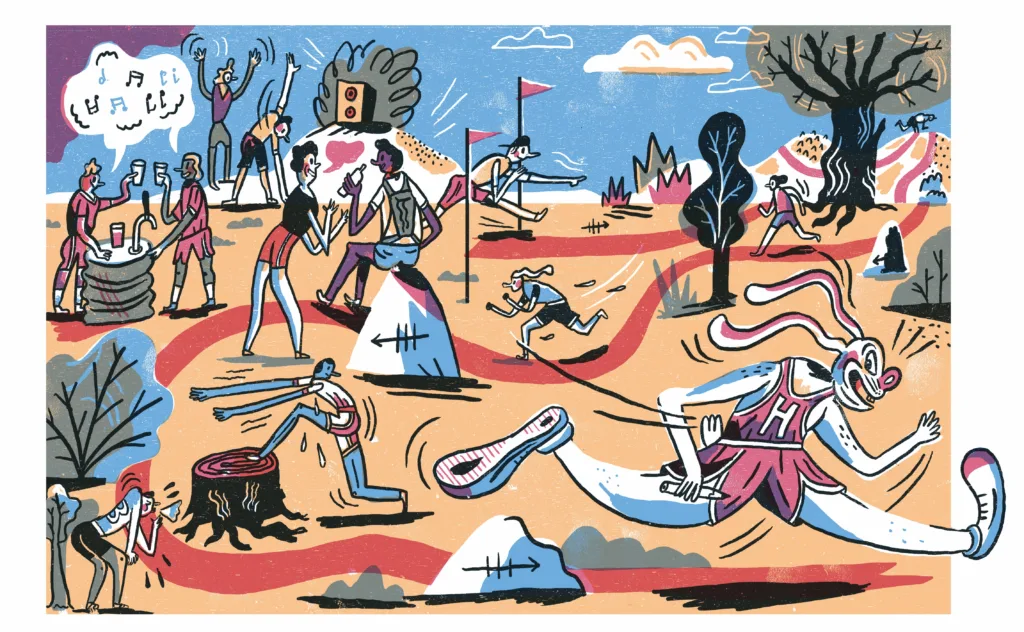
Trail. Ale. Repeat.
Dissecting the Hash House phenomenon.
Hashing, for our purposes, isn’t the hashing in a dictionary definition. Rather, it’s an entirely different animal—the perfect marriage of sweat and socializing. Proudly described by those in the know as a “drinking club with a running problem,” it turns exercise into adventure as “hares” lay trails marked with flour or chalk (or Jello powder) for the “pack” to follow. Considered a unique blend of orienteering and partying, it often it incorporates beer stops along the way, enhancing the social aspect of the sport. After conquering trails through varied terrain, hashers celebrate with food, drinks, and mischievous rituals—complete with humorous “down downs” for on-trail misdeeds. In a nutshell, hashing is athletic hedonism at its finest—a liberating escape from routine that delivers exercise, camaraderie, and pure, unadulterated fun.
Hashing History
In 1938, a group of British soldiers stationed in Malaysia began the habit of meeting every Friday evening following the traditional game of Hare & Hounds. A.S. Gispert, an original member, suggested the name Hash House Harriers, taking inspiration from the Selangor Club in Kuala Lumpur, where the group met. The club was known as Hash House—”hash” being old British slang for “bad food.”
After a hiatus during World War II, hashing was restarted in 1946. Though Gispert—known affectionately as “G”—was killed during the war, several chapters celebrate his legacy with an annual Gispert Memorial Run.
Hashing spread far and wide during the mid-1970s. Today there are almost 1,500 chapters around the globe—even Antarctica has its own.
Hashing Run wild
Hashing comes in different shapes and sizes—on land, on sea, and in snow. Check out its different variations around the world:
Hash House Bikers is the most popular iteration, following running, with the oldest hashing biker club dating back to 1989.
River Hashes or Snorkel Hashesis hashing but the aquatic version. They can be aboard a vessel, like a kayak or a raft, or underwater with snorkels.
Snow Hashing is the hash most similar to regular hashing, but the trails on the snow are marked with blue carpenter’s chalk and sometimes even with Jello mix.
Snow hashing is also known as Ski Hashing.
A Hash-a-Thon features multiple trails totaling 26.2 miles.
Family Hashes welcome children with soft drinks that replace alcohol.
Tri-Hash-a-Thon combines three different trails—running, aquatic, and biking.
The Tour-Duh-Hash features teams hashing 42 km through the Malaysian jungle in a week, paying homage to hashing’s Southeast Asian origin.
Trail Marks
An arrow with three lines. This is the “true trail,” meaning you should follow the direction of the arrow.
A circle. This means the trail may go in any direction, and the hounds must fan out in search of the next mark.
Three horizontal lines. This is the dreaded “false trail,” requiring you to backtrack. It’s designed to keep the fast runners from getting too far ahead.
Harriers & Harriettes
Hashing has developed its own peculiar vocabulary. Some of our favorites follow:
Down-Down: The ceremony of quaffing a beverage, an honor.
Harrier: male hasher
Harriette: female hasher
Hashit: offensive or embarrassing object given to a hasher for notable on-trail accomplishments, normally carried by the awardee on subsequent trails until it is awarded to someone else
Knitting Circle: group of harriers or harriettes (usually the latter) who spend more time walking and talking than hashing.
Receding Hareline: list of future run dates and locations.
Shagpile: Hashname for a hasher of extreme intelligence, good looks, sexual prowess but less than moderate fitness.
Shiggy: thick vegetation, streams, etc; especially mud.
This article originally appeared in the June 2025 issue.
